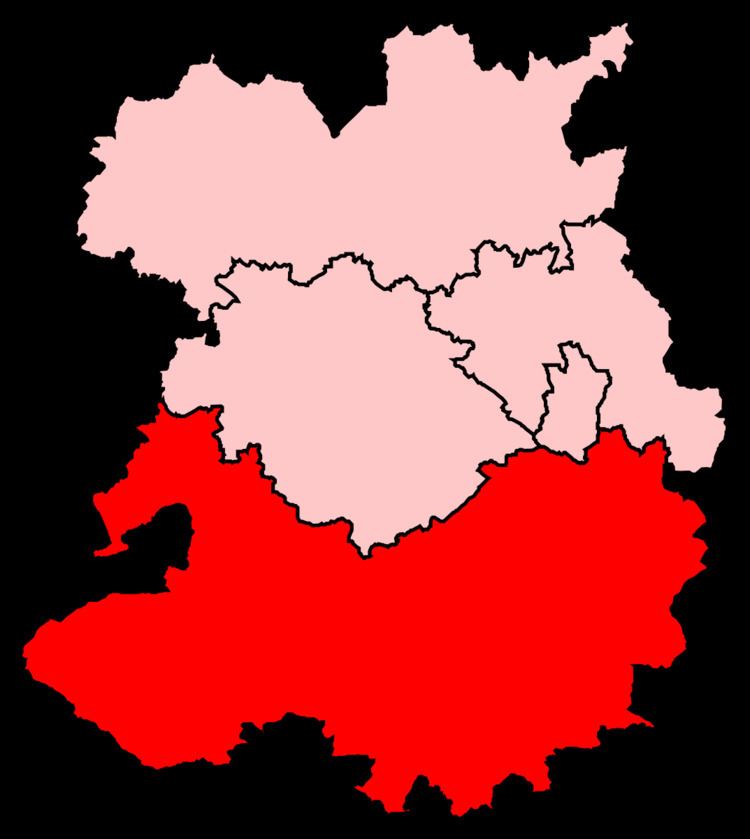Created 1885 | Electorate 66,199 (December 2010) Number of members One | |
 | ||
Major settlements Ludlow, Bridgnorth, Broseley, Clun, Bishop's Castle, Cleobury Mortimer, Much Wenlock, Craven Arms and Church Stretton Member of parliament | ||
Ludlow is a constituency represented in the House of Commons of the UK Parliament since 2005 by Philip Dunne, a Conservative.
Contents
History
From its 1473 creation until 1885, Ludlow was a parliamentary borough. It was represented by two burgesses until 1868, when it was reduced to one member.
The parliamentary borough was abolished in 1885, and the name transferred to the new county "division" (with lower electoral candidates' expenses and a different returning officer) whose boundaries were expanded greatly to become similar to (and a replacement to) the Southern division of Shropshire.
The seat was long considered safe for the Conservatives with the party winning by large majorities from the 1920s until 1997 when the majority was reduced to under 6,000. When the sitting Conservative MP stood down in 2001 it was won by a Liberal Democrat. Ludlow was regained by a Conservative in the 2005 general election, held with a greatly increased majority five years later which was almost doubled in 2015.
Boundaries and profile
1885-1918: Parts of the Municipal Boroughs of Bridgnorth, Ludlow, and Wenlock, the Sessional Divisions of Bishop's Castle, Brinstree South and Stottesden Chelmarsh, Burford, Clun and Purslow, Munslow Lower and Upper, Stottesden Cleobury, and parts of the Sessional Divisions of Ovens and Stottesden.
1918-1950: The Municipal Boroughs of Bishop's Castle, Bridgnorth, and Ludlow, the Urban District of Church Stretton, and the Rural Districts of Bridgnorth, Burford, Church Stretton, Cleobury Mortimer, Clun, Ludlow, and Teme.
1950-1974: The Municipal Boroughs of Bishop's Castle, Bridgnorth, Ludlow, and Wenlock, the Urban District of Church Stretton, and the Rural Districts of Bridgnorth, Clun, and Ludlow.
1974-1983: The Rural Districts of Bridgnorth, Clun and Bishop's Castle, and Ludlow.
1983-1997: The District of South Shropshire, and the District of Bridgnorth.
1997-2010: The District of South Shropshire, and the District of Bridgnorth wards of Alveley, Bridgnorth Castle, Bridgnorth East, Bridgnorth Morfe, Bridgnorth West, Broseley, Claverley, Ditton Priors, Glazeley, Harrington, Highley, Kinlet, Much Wenlock, Morville, Stottesdon, and Worfield.
2010-present: The District of South Shropshire, and the District of Bridgnorth wards of Alveley, Bridgnorth Castle, Bridgnorth East, Bridgnorth Morfe, Bridgnorth West, Broseley East, Broseley West, Claverley, Ditton Priors, Glazeley, Harrington, Highley, Much Wenlock, Morville, Stottesdon, and Worfield.
nb. in April 2009 the districts of South Shropshire and Bridgnorth (together with their wards) were abolished; the constituency's extent however is still constituted by reference to them, and will be until the next completed review of constituencies in England.
The Ludlow constituency is situated entirely within the county of Shropshire in England.
It covers a large, rural area dotted with market towns, the largest of which are Ludlow and Bridgnorth (which was a borough constituency until 1885), each having a population of just over 10,000. The other towns — all with a population of under 5,000 — are Broseley, Clun, Bishop's Castle (a 'rotten borough' constituency until 1832), Cleobury Mortimer, Much Wenlock (former seat of the borough constituency of Wenlock until 1885 and notable for its part in the history of the modern Olympic Games movement), Craven Arms and Church Stretton.
On its northeast border (just beyond Broseley) is the Ironbridge Gorge (notable for its part in the Industrial Revolution), just to the south of the large new town of Telford. The Guardian encapsulates the seat in a nutshell as "Big, rural, hills and small towns, increasingly middle class." Other than the Telford borough constituency, Ludlow borders onto similarly rural county constituencies, including Montgomery on the other side of the border with Wales.
The constituency covers most of the south area of Shropshire Council (without Shifnal and Albrighton).
The most recent boundary changes took place at the 1997 general election, when a part of the Bridgnorth district was removed to The Wrekin constituency.
Proposed changes: Under constituency boundary proposals announced in September 2016, ahead of the next general election, the Bridgnorth, Much Wenlock and Broseley areas of the seat will merge into a new constituency called Telford, Wellington and The Wrekin, and the ward of Chirbury and Worthen into the Shrewsbury constituency, while the remainder will amalgamate with the North Herefordshire constituency to form a new seat called Ludlow & Leominster.
MPs 1473–1660
MPs 1868–1885
Elections in the 1940s
General Election 1939/40: Another general election was required to take place before the end of 1940. The political parties had been making preparations for an election to take place from 1939 and by the end of this year, the following candidates had been selected;
Elections in the 1910s
‡ endorsed by the Coalition Government
Elections in the 1910s
General Election 1914/15:
Another General Election was required to take place before the end of 1915. The political parties had been making preparations for an election to take place and by the July 1914, the following candidates had been selected;
